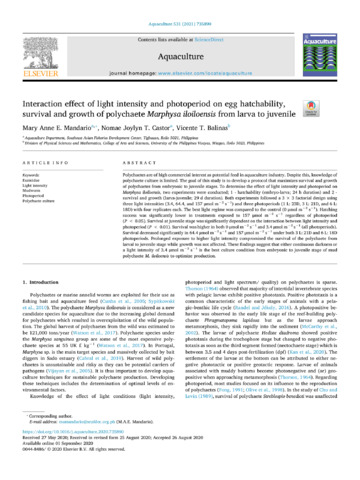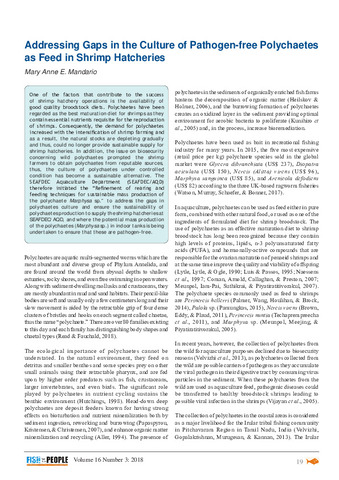Interaction effect of light intensity and photoperiod on egg hatchability, survival and growth of polychaete Marphysa iloiloensis from larva to juvenile
- Global styles
- MLA
- Vancouver
- Elsevier - Harvard
- APA
- Help
Share
Abstract
Polychaetes are of high commercial interest as potential feed in aquaculture industry. Despite this, knowledge of polychaete culture is limited. The goal of this study is to develop a protocol that maximizes survival and growth of polychaetes from embryonic to juvenile stages. To determine the effect of light intensity and photoperiod on Marphysa iloiloensis, two experiments were conducted; 1 - hatchability (embryo-larva; 24 h duration) and 2 - survival and growth (larva-juvenile; 29 d duration). Both experiments followed a 3 × 3 factorial design using three light intensities (3.4, 64.4, and 157 μmol m−2 s−1) and three photoperiods (1 L: 23D, 3 L: 21D, and 6 L: 18D) with four replicates each. The best light regime was compared to the control (0 μmol m−2 s−1). Hatching success was significantly lower in treatments exposed to 157 μmol m−2 s−1 regardless of photoperiod (P < 0.05). Survival at juvenile stage was significantly dependent on the interaction between light intensity and photoperiod (P < 0.01). Survival was higher in both 0 μmol m−2 s−1 and 3.4 μmol m−2 s−1 (all photoperiods). Survival decreased significantly in 64.4 μmol m−2 s−1 and 157 μmol m−2 s−1 under both 3 L: 21D and 6 L: 18D photoperiods. Prolonged exposure to higher light intensity compromised the survival of the polychaete from larval to juvenile stage while growth was not affected. These findings suggest that either continuous darkness or a light intensity of 3.4 μmol m−2 s−1 is the best culture condition from embryonic to juvenile stage of mud polychaete M. iloiloensis to optimize production.
Keywords
Mudworm Polychaete cultureSuggested Citation
Mandario, M. A., Castor, N. J. T., & Balinas, V. T. (2021). Interaction effect of light intensity and photoperiod on egg hatchability, survival and growth of polychaete Marphysa iloiloensis from larva to juvenile. Aquaculture , 531, 735890. https://doi.org/10.1016/j.aquaculture.2020.735890
Type
ArticleISSN
0044-8486Collections
- Journal Articles [1258]
Related items
Showing items related by title, author, creator and subject.
-
Addressing gaps in the culture of pathogen-free polychaetes as feed in shrimp hatcheries
One of the factors that contribute to the success of shrimp hatchery operations is the availability of good quality broodstock diets. Polychaetes have been regarded as the best maturation diet for shrimps as they contain ... -
Survival, growth and biomass of mud polychaete Marphysa iloiloensis (Annelida: Eunicidae) under different culture techniques
Polychaetes are commercially exploited as fishing bait and supplemental diet to crustacean and finfish broodstock. However, scarcity of supply and biosecurity issues limits its use. Polychaete aquaculture has become the ... -
Evaluation of the bioremediation potential of mud polychaete Marphysa sp. in aquaculture pond sediments
Organic enrichment from aquaculture could alter the chemical composition of the fishpond bottom by increasing the levels of organic matter (OM), sulfur (S), iron (Fe), and lower pH of the sediment. Polychaetes can contribute ...







